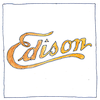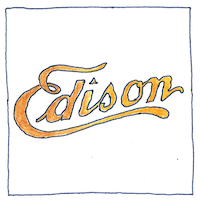Thomas Edison
philosophy of science

|
Industrial research laboratory
Thomas Edison sold his quadruplex telegraph to Western Union and used the money to build the first industrial research laboratory in Menlo Park, New Jersey, and to hire a large team of engineers, physicists, craftsmen, and accountants to conduct research and development under his direction.
Perspiration
“Genius is one percent inspiration, ninety-nine percent perspiration.” —Thomas A. Edison, Harper’s Monthly, September 1932.
Inventions
Edison or his employees invented the printing telegraph, the stencil-pen and the perforating pen, the quadruplex telegraph, the carbon microphone, the phonomotor (a motor driven by sound), the phonograph, the phonograph recorder, and the phonograph reproducer, the kinetoscope, the dictaphone, the autographic printer, the magnetic ore-separator, the printer working by repeated impacts of a stylus, the electric fuse, and the talking doll. They improved the zinc-copper acid battery, the incandescent light bulb, the ticker-tape machine, the fluoroscope, and the telephone.
Employees
Edward Hibberd Johnson hired the young Edison at the Automatic Telegraph Company and later worked as Edison’s executive and partner; Charles Batchelor, Edison’s chief experimental assistant, worked on projects in telegraphy, telephony, the phonograph, and electric lighting and became general manager of General Electric Company; John Kruesi, a clockmaker, became Edison’s head machinist and built prototypes for Edison’s inventions; Francis Robbins Upton, physicist and mathematician, worked with Edison on the light bulb, the watt-hour meter, and power distribution, and invented the first fire alarm sensor; Francis Jehl was one of Edison’s laboratory assistants and helped develop the incandescent light bulb; William Joseph Hammer helped develop the light bulb invented the first electric advertising sign and became an expert in power distribution; Samuel Insull built power stations for Edison and was one of the founders of Edison General Electric; Frank J. Sprague introduced mathematical methods at Edison’s laboratory in Menlo Park and corrected Edison’s electric distribution systems; after leaving Edison, Sprague introducted regenerative braking; he became known as the father of electric traction; Nikola Tesla worked briefly for Edison but soon went out on his own invented the AC induction motor and sold it to Edison’s rival George Westinghouse; Edison hired Lewis Howard Latimer as a draftsman, but Latimer had already invented an improved toilet system for railroad cars and a method for producing carbon filaments for light bulbs; Arthur E. Kennelly and Harold P. Brown invented the electric chair; Hermann Lemp worked with Edison on his first electric locomotives and later invented the controller for the first diesel-electric locomotive. William Kennedy Dickson developed Edison’s kinetoscope and invented motion picture film, Eugene Augustin Lauste, Dickson’s assistant, invented the Latham loop and the first sound on film; Clarence Madison Dally, a glassblower, worked with his brother, Charles, on Edison’s X-ray focus tube, developing a better fluoroscope, and volunteered to test the equipment, subsequently becoming the first victim of radiation dermatitis; Edwin S. Porter created and directed over 250 films for Edison Pictures and invented the fade-in. Miller Reese Hutchison worked as Edison’s chief engineer, and invented the hearing aid, the electric Klaxon horn, and an electric tachometer for steam ships.
Inventing
Many people could advise if you need help sitting before a blank piece of paper, a threatening, accusatory blank piece of paper. Necessity can also be threatening and accusatory, but maybe your necessity is warm and comforting; maybe your blank piece of paper is an inviting doorway. Think of it that way, and when any little rascal shows its little head in your doorway, don’t let it escape, don’t wait for any other, but get its statement and measurements, and never never think that you must make it anything other than it really is.



In 1809, Humphry Davy invented the first electric light, a platinum strip connected to the Royal Institute’s powerful voltaic battery. Humphry Davy and Michael Faraday collaborated on electrolysis experiments in the laboratory of the Royal Institute, making it an important precident for the modern industrial research laboratory.
See also in The book of science:
Readings in wikipedia:
Other readings: